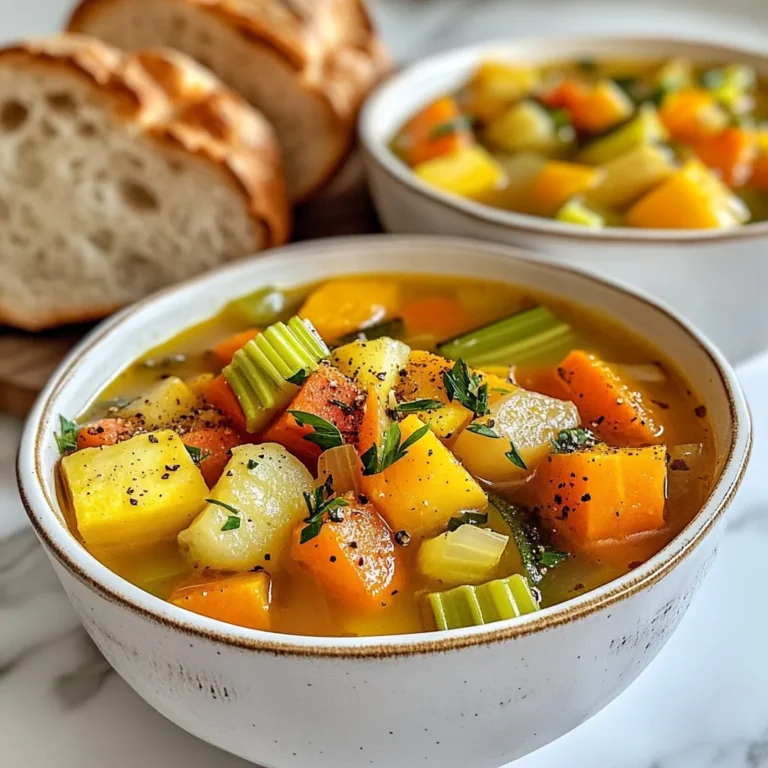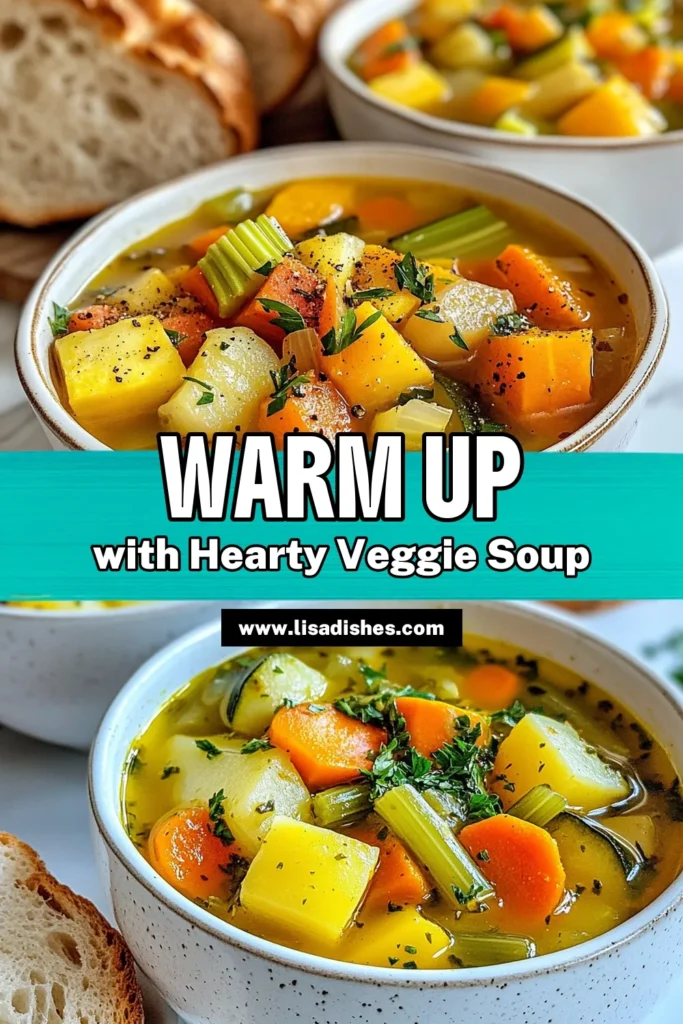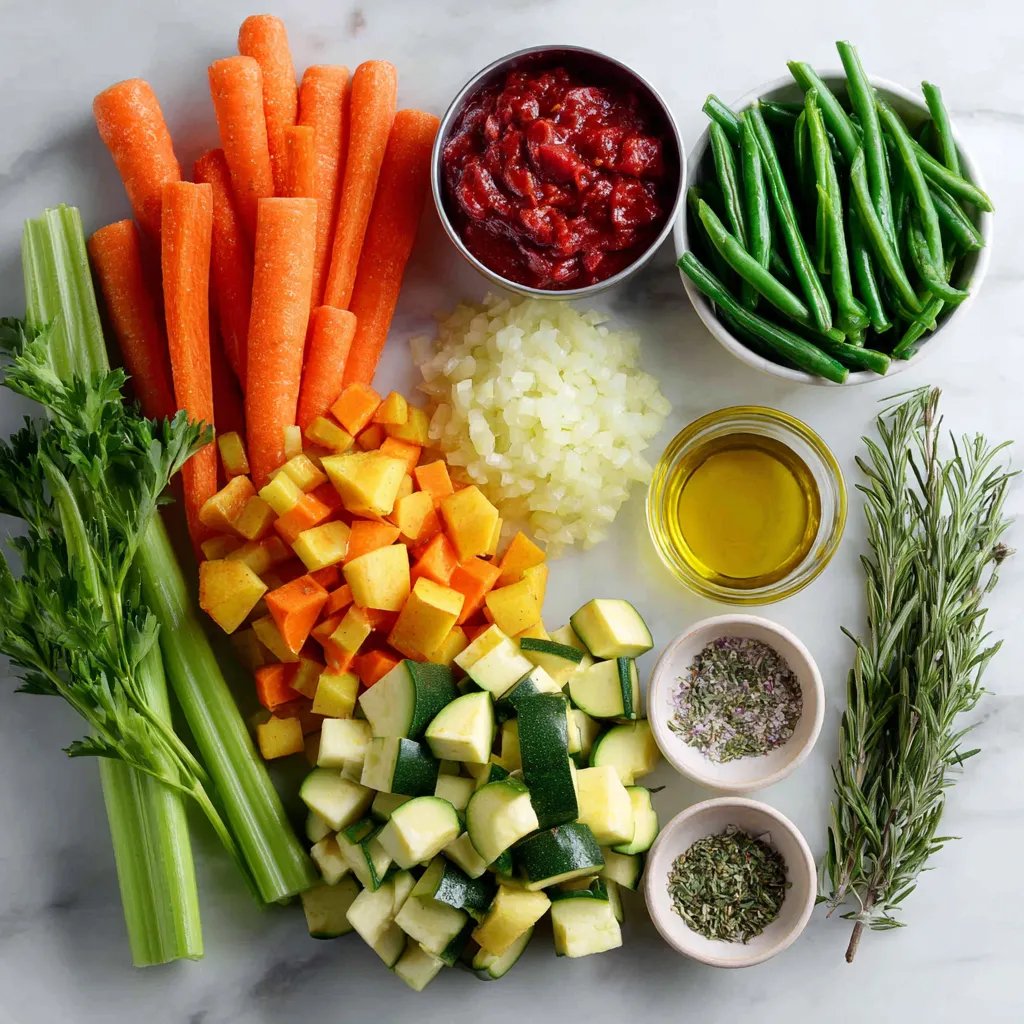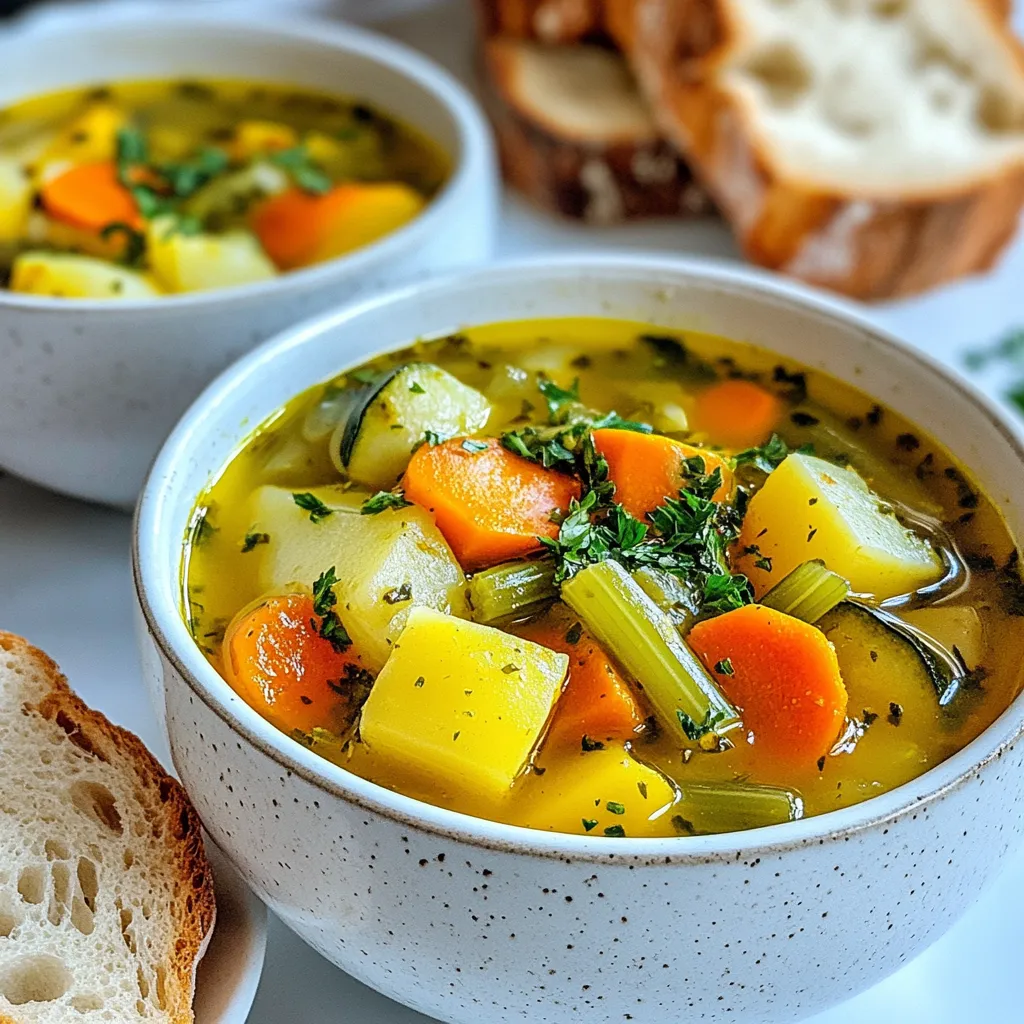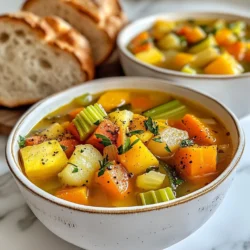WANT TO SAVE THIS RECIPE?
Warm up this winter with a bowl of my Winter Vegetable Soup! Packed with fresh veggies, this comforting delight is both flavorful and healthy. You can enjoy it as a cozy meal on chilly days or as a nutritious option to keep you energized. Plus, I’ll guide you through simple steps to create the perfect blend of tastes and textures. Dive into this recipe and discover how easy it is to relish winter’s bounty!
Why I Love This Recipe
- Comforting Warmth: This soup is the perfect remedy for chilly winter days, providing a warm and cozy meal that soothes the soul.
- Hearty and Nutritious: Packed with a variety of vegetables, this soup is not only filling but also loaded with vitamins and minerals.
- Easy to Make: The straightforward instructions make it simple for anyone to whip up a delicious pot of soup without much fuss.
- Customizable: Feel free to adjust the ingredients based on what you have on hand or your personal preferences, making it a versatile recipe.
Ingredients
Here’s what you need to make a warm bowl of winter vegetable soup. Gather these fresh and tasty ingredients:
– 2 tablespoons olive oil
– 1 onion, chopped
– 2 cloves garlic, minced
– 3 carrots, sliced
– 2 celery stalks, diced
– 1 medium potato, diced
– 1 medium sweet potato, diced
– 1 zucchini, chopped
– 1 cup green beans, chopped
– 1 can (14 oz) diced tomatoes (with juice)
– 4 cups vegetable broth
– 1 teaspoon dried thyme
– 1 teaspoon dried rosemary
– 1 bay leaf
– Salt and pepper to taste
– Fresh parsley, chopped (for garnish)
Using fresh vegetables enhances flavor and nutrition. Olive oil adds a rich taste and helps cook the onion and garlic. Each ingredient has its role, from the sweetness of carrots to the earthiness of potatoes. This blend of vegetables creates a comforting soup perfect for chilly days.
Feel free to get creative. You can swap in seasonal veggies or those you love. Winter vegetable soup is flexible and can fit any palate. Enjoy the process of choosing your ingredients!

Step-by-Step Instructions
Preparing the Vegetables
Start by chopping your onion into small pieces. This helps it cook evenly. Next, mince the garlic. Use a knife to chop it finely. Garlic adds a nice flavor.
In a large pot, heat 2 tablespoons of olive oil over medium heat. Add the chopped onion. Sauté it for 3 to 4 minutes until it turns translucent. Then, add the minced garlic. Sauté for another minute. You want to smell the garlic’s wonderful aroma.
Now, slice the carrots and dice the celery. Stir these into the pot. Cook them for about 5 minutes. They should start to soften.
Next, dice the potato and sweet potato. Add them to the pot and cook for another 4 minutes. This step adds depth to your soup.
Finally, chop the zucchini and green beans. Stir these in to complete the vegetable prep.
Cooking the Soup
It’s time to add your vegetables in stages. First, add the carrots and celery, then the potatoes and sweet potatoes. This way, each veggie gets enough cooking time.
Now, pour in the can of diced tomatoes, including the juice. This adds a rich flavor. Next, add 4 cups of vegetable broth. The broth brings everything together and makes the soup hearty.
Season the mix with 1 teaspoon each of dried thyme and rosemary, plus 1 bay leaf. These herbs give your soup a warm flavor. Bring the soup to a boil, then reduce the heat. Let it simmer for about 25 to 30 minutes. This time lets all the flavors blend together.
Finalizing the Soup
After simmering, all your vegetables should be tender. Remove the bay leaf. This leaf adds flavor but is not meant to be eaten.
Now, taste the soup. Add salt and pepper to fit your taste. You can use an immersion blender to blend part of the soup for a creamier texture. Blend just enough to keep some chunks.
Ladle the soup into bowls and garnish with fresh chopped parsley. This adds a fresh touch and color. Enjoy your cozy winter vegetable soup!
Tips & Tricks
Perfecting the Flavor
To make your soup taste amazing, use fresh herbs. Dried thyme and rosemary work well. They add richness and depth. You can even try adding basil or oregano for a twist. For texture, you can blend part of the soup. An immersion blender is perfect for this. Blend until smooth, but leave some chunks. This gives a nice mix of creamy and hearty bites.
Serving Suggestions
Pair your soup with crusty bread or warm cheese. A slice of sourdough or baguette complements the soup nicely. You can also serve it with a sprinkle of cheese on top. For presentation, use rustic bowls. A garnish of fresh parsley adds color and freshness. You could even add a drizzle of olive oil for an extra touch.
Common Mistakes to Avoid
Avoid overcooking your veggies. This can make them mushy and bland. Cook just until tender for the best flavor. Also, be careful with seasoning. Too much salt or pepper can ruin your soup. Taste as you go to find the right balance. Adjust your herbs and salt to suit your taste.
Pro Tips
- Use Fresh Vegetables: Fresh vegetables enhance the flavor and nutritional value of the soup. Try to use seasonal produce for the best taste.
- Adjust Consistency: If you prefer a thicker soup, blend a portion of the soup with an immersion blender. This adds creaminess while keeping some texture.
- Herb Variations: Experiment with different herbs like basil or parsley for a unique flavor twist. Fresh herbs added at the end can brighten the dish even more.
- Make It Ahead: This soup tastes even better the next day! Make a big batch and store leftovers in the fridge or freezer for a quick meal later.

Variations
Additional Vegetables
You can add many seasonal veggies. Think about using:
– Kale
– Spinach
– Butternut squash
– Leeks
– Parsnips
These options boost flavor and nutrients. They also add color to your soup. You can mix and match as you like.
Dietary Adjustments
Want to make it vegan? Simply skip the broth that has animal products. Use vegetable broth instead. This soup is already gluten-free, but check the broth. Ensure it is labeled gluten-free if you need it.
If you have allergies, avoid any veggies that trigger you. You can use safe alternatives. For example, swap garlic with shallots.
Flavor Profiles
Adding spices can change the soup’s kick. Try:
– Crushed red pepper for heat
– Cumin for warmth
– Paprika for smokiness
For a creamy version, blend part of the soup. You can also add coconut milk or cream for richness. This makes it smooth and luxurious. Enjoy exploring these options!
Storage Info
Leftover Storage
To store your winter vegetable soup in the refrigerator, let it cool first. Then, transfer it to an airtight container. This helps keep the soup fresh. Use glass or BPA-free plastic containers for safe storage. Label the containers with the date for easy tracking.
Freezing Instructions
For freezing, pour the soup into freezer-safe containers. Leave some space at the top for expansion. You can also use freezer bags for easy stacking. To reheat, thaw the soup overnight in the fridge. Heat it on the stove over low heat. Stir occasionally until hot.
Shelf Life
In the fridge, your soup lasts about 4-5 days. If frozen, it can last up to 3 months. Always check for signs of spoilage. If it smells off or looks strange, it’s best to toss it.
FAQs
How can I make Winter Vegetable Soup spicier?
To make your Winter Vegetable Soup spicier, add red pepper flakes or diced jalapeños. Start with a small amount, then taste and adjust. You can also use hot sauce for a quick kick. Adding spices like cumin or smoked paprika can enhance the heat and flavor too.
Can I use frozen vegetables in this recipe?
Yes, you can use frozen vegetables for this soup. They are convenient and can save time. Just toss them in when you would add the fresh vegetables. Keep in mind that frozen veggies may cook faster. So, adjust your cooking time as needed.
What are the best herbs for vegetable soup?
The best herbs for vegetable soup include thyme, rosemary, and bay leaves. These herbs add depth and warmth. Fresh herbs like parsley or basil can be added at the end for brightness. You can also try dill or oregano for a different flavor twist.
How can I make a low-sodium version of this soup?
To make a low-sodium version, use low-sodium vegetable broth or make your own. Avoid adding extra salt until the end. Fresh herbs and spices can add flavor without the need for salt. Always taste before adding any extra seasoning.
Can I add protein to my Winter Vegetable Soup?
Yes, adding protein boosts the soup’s nutrition. You can include beans, lentils, or cooked chicken. Tofu or chickpeas also work great for a vegetarian option. Just add them in during the last few minutes of cooking to heat through.
This winter vegetable soup recipe is simple and packed with flavor. We covered the key ingredients, step-by-step instructions, and helpful tips to ensure success. I shared ways to customize the soup to fit your taste and dietary needs. Remember, avoid overcooking and balance your seasoning. Store leftovers properly to enjoy later. With these ideas, you can create a warm, comforting dish perfect for any cold day. Dive in and make this soup your ow
Cozy Winter Vegetable Soup
A warm and hearty vegetable soup perfect for cold winter days.
Prep Time 15 minutes mins
Cook Time 35 minutes mins
Total Time 50 minutes mins
Course Main Course
Cuisine American
Servings 6
Calories 150 kcal
- 2 tablespoons olive oil
- 1 onion, chopped
- 2 cloves garlic, minced
- 3 carrots, sliced
- 2 celery stalks, diced
- 1 medium potato, diced
- 1 medium sweet potato, diced
- 1 zucchini, chopped
- 1 cup green beans, chopped
- 1 can (14 oz) diced tomatoes (with juice)
- 4 cups vegetable broth
- 1 teaspoon dried thyme
- 1 teaspoon dried rosemary
- 1 bay leaf
- Salt and pepper to taste
- Fresh parsley, chopped (for garnish)
In a large pot, heat the olive oil over medium heat. Add the chopped onion and sauté for 3-4 minutes until translucent.
Add the minced garlic and sauté for an additional minute until fragrant.
Stir in the sliced carrots and diced celery, cooking for 5 minutes until they begin to soften.
Add the diced potato and sweet potato, and cook for another 4 minutes.
Mix in the chopped zucchini and green beans, stirring well.
Pour in the can of diced tomatoes along with their juice, and add the vegetable broth.
Season with dried thyme, rosemary, and the bay leaf. Bring the soup to a boil, then reduce the heat and let it simmer for about 25-30 minutes, or until all the vegetables are tender.
Remove the bay leaf and season the soup with salt and pepper to taste.
For added depth, you can use an immersion blender to blend a portion of the soup, leaving some texture.
Ladle the soup into bowls and garnish with fresh chopped parsley before serving.
Serve the soup in rustic bowls with a slice of crusty bread on the side, and a sprinkle of extra parsley for color.
Keyword healthy, soup, vegetable, winter
WANT TO SAVE THIS RECIPE?
